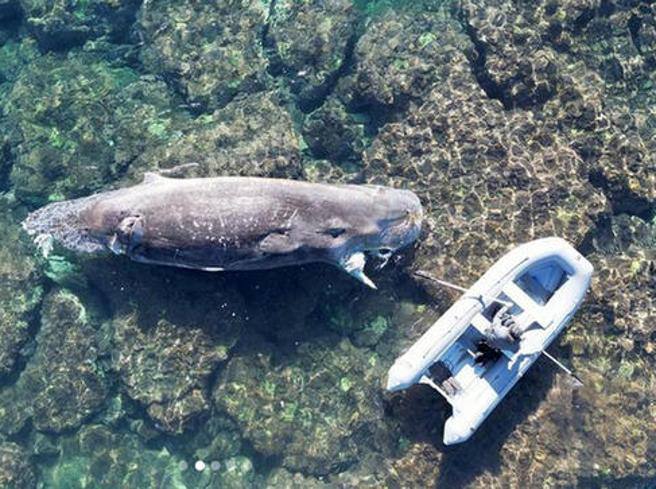A picture that will remain among those that will mark this year. We are talking about the sperm whale found stranded on December 27th in the Baia d’Argento of Leporano (Taranto), sunk after being wrapped in a net to minimize the dispersion of organic material.
As communicated by the Jonian Dolphin Conservation association, “the size of the animal and the logistical difficulty linked to the complexity of the rocky coast made disposal impossible, leading to the decision to opt for a controlled sinking of the animal.” The sperm whale, about 12 meters long, was an adult female.
According to the association, the laceration suffered by the animal is linked to an acute traumatic fracture resulting from impact with a large boat propeller. After several days of preparation, “the animal was sunk thanks to the intervention of the Multicat (a floating crane, ed.)
of Ecotaras and a 2.5-ton ballast. The event is of great scientific relevance and regular monitoring will be crucial to understand the decomposition process of such an important animal, initiating important research actions,” add the experts.
At the end of the operations, a farewell message was posted on Instagram: “We realize the immense heritage we have lost. Due to human carelessness in carrying out its activities, the sea is always subjected to new threats to which it cannot cope.
This time, a sperm whale paid the price. Losing a female is a great loss, but we understood the gravity of the situation when we discovered that the mammary glands contained milk.
A reference to the wife of Falanto, the historic founder of Taranto who arrived along the Taranto coast pushed by the sea. A name that comes from the past and will accompany this sperm whale forever.
“January 12, 2024 (modified on January 14, 2024 | 09:59)
© REPRODUCTION RESERVED
Una imagen que permanecerá entre aquellas que marcarán este año. Estamos hablando del cachalote encontrado varado el 27 de diciembre en la Baia d’Argento de Leporano (Taranto), hundido después de ser envuelto en una red para minimizar la dispersión de material orgánico.
Según lo comunicado por la asociación Jonian Dolphin Conservation, “el tamaño del animal y la dificultad logística relacionada con la complejidad de la costa rocosa hicieron imposible la disposición, lo que llevó a la decisión de optar por un hundimiento controlado del animal”. El cachalote, de unos 12 metros de longitud, era una hembra adulta.
Según la asociación, la laceración sufrida por el animal está vinculada a una fractura traumática aguda resultante del impacto con una gran hélice de barco. Después de varios días de preparación, “el animal fue hundido gracias a la intervención del Multicat (una grúa flotante, ed.)
de Ecotaras y un lastre de 2,5 toneladas. El evento es de gran relevancia científica y el monitoreo periódico será crucial para comprender el proceso de descomposición de un animal tan importante, iniciando importantes acciones de investigación,” agregan los expertos.
Al final de las operaciones, se publicó un mensaje de despedida en Instagram: “Nos damos cuenta del inmenso patrimonio que hemos perdido. Debido a la negligencia humana en llevar a cabo sus actividades, el mar siempre está sujeto a nuevas amenazas a las que no puede hacer frente.
Esta vez, un cachalote pagó el precio. Perder a una hembra es una gran pérdida, pero entendimos la gravedad de la situación cuando descubrimos que las glándulas mamarias contenían leche.
Una referencia a la esposa de Falanto, el histórico fundador de Taranto que llegó a lo largo de la costa de Taranto empujado por el mar. Un nombre que viene del pasado y acompañará a este cachalote para siempre.
12 de enero de 2024 (modificado el 14 de enero de 2024 | 09:59)
© REPRODUCCIÓN RESERVADA
